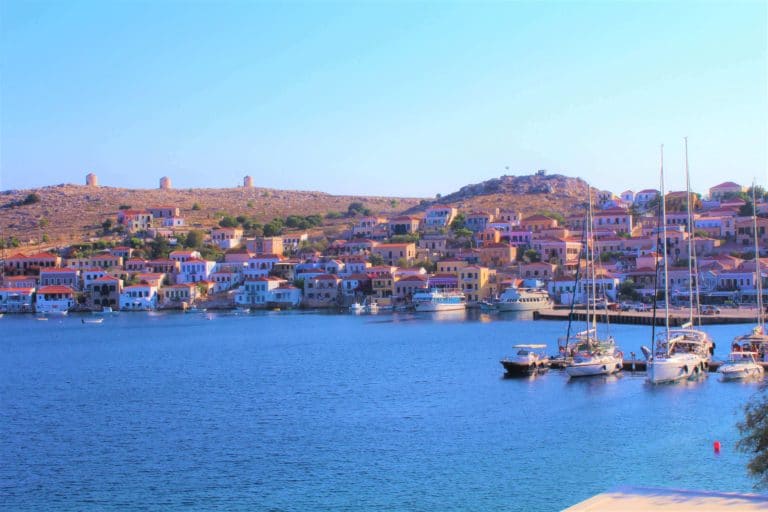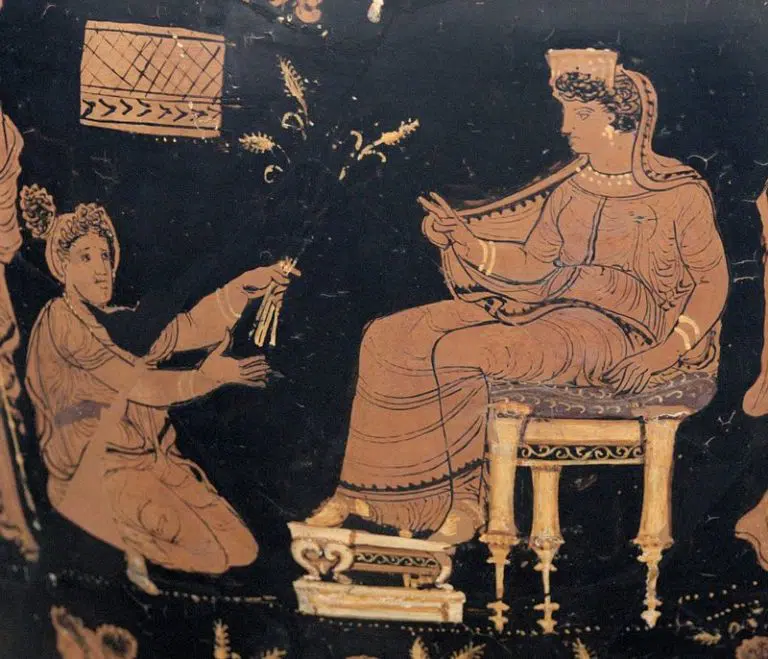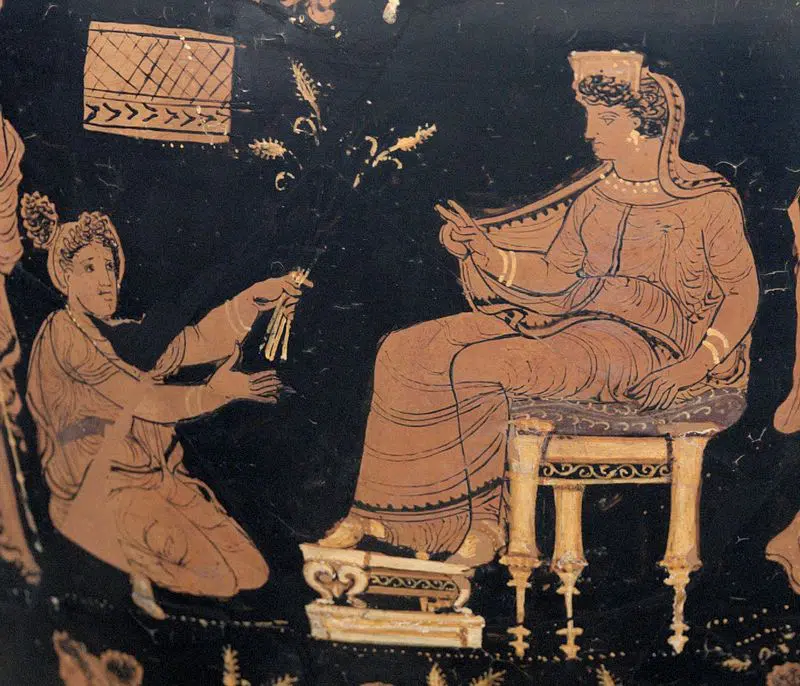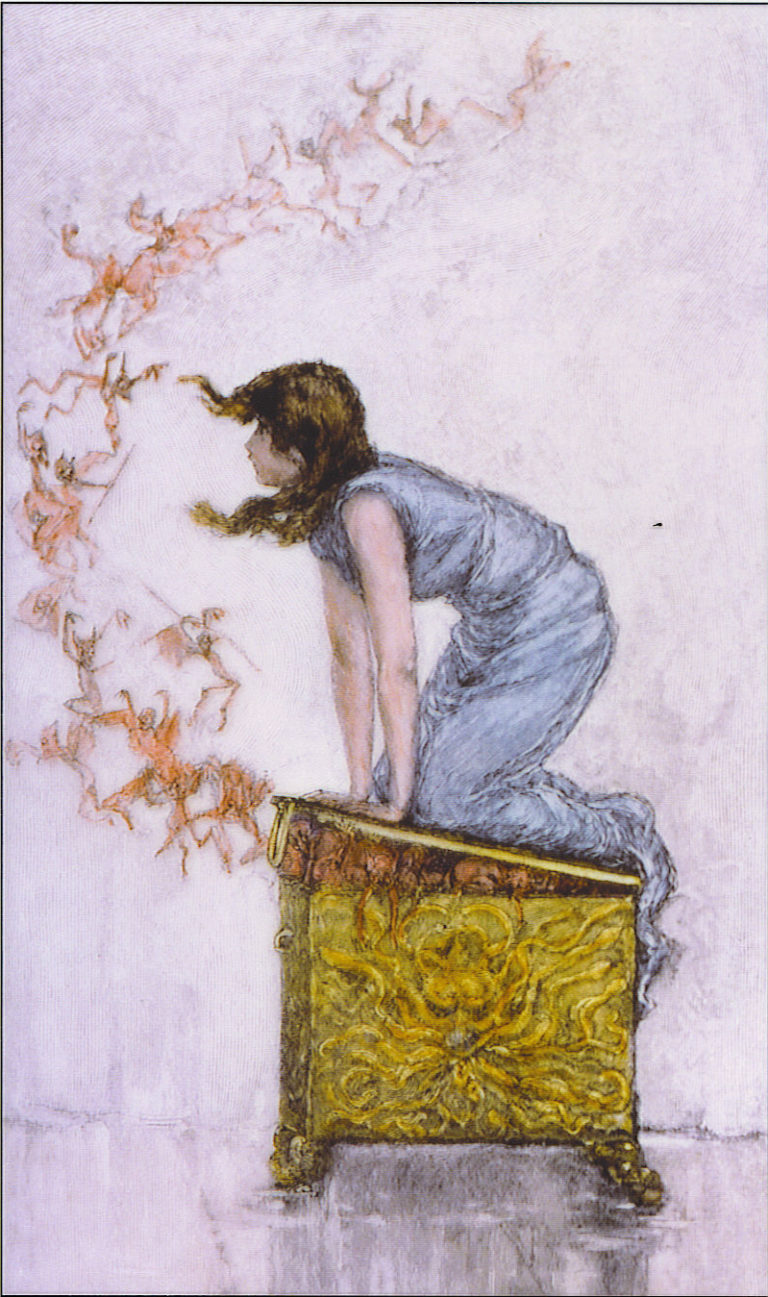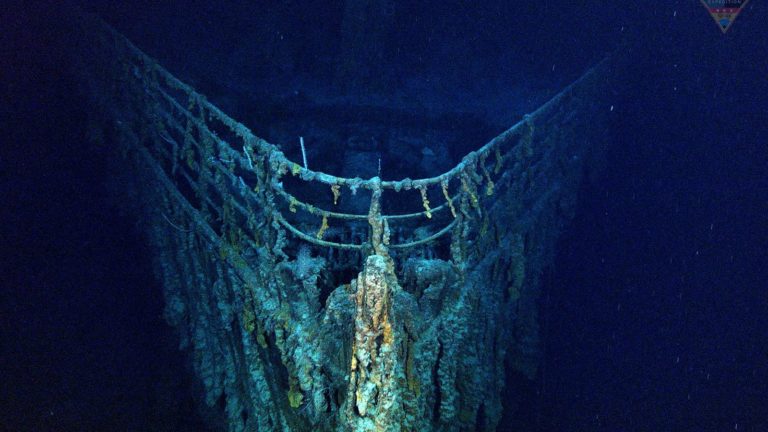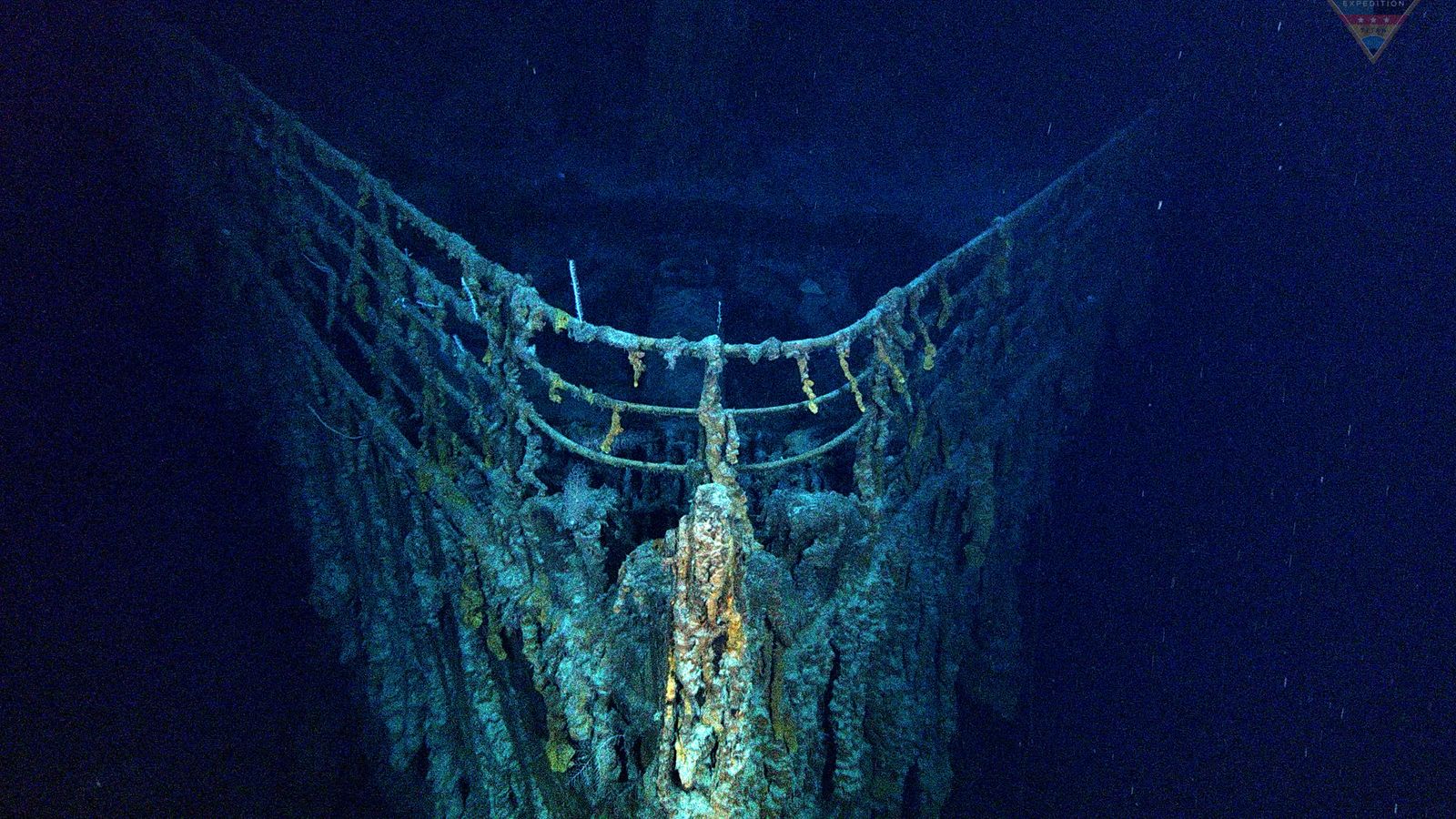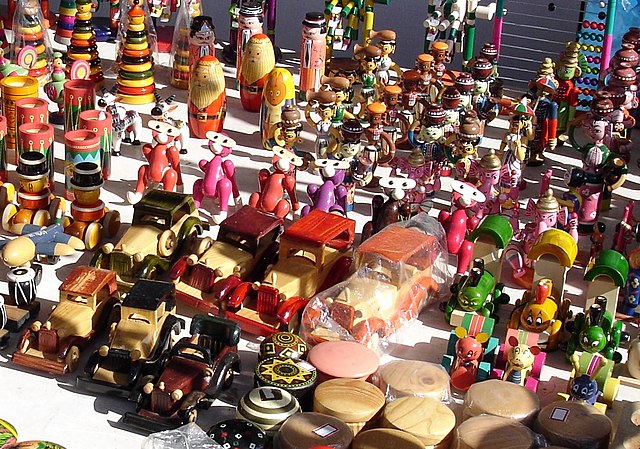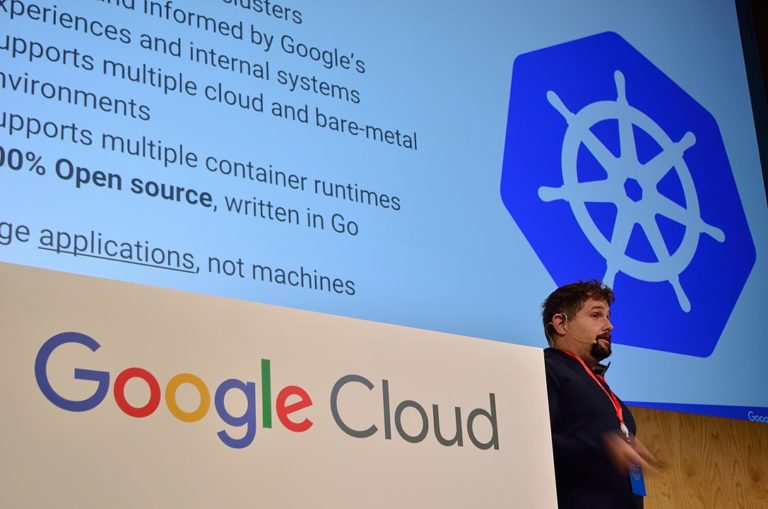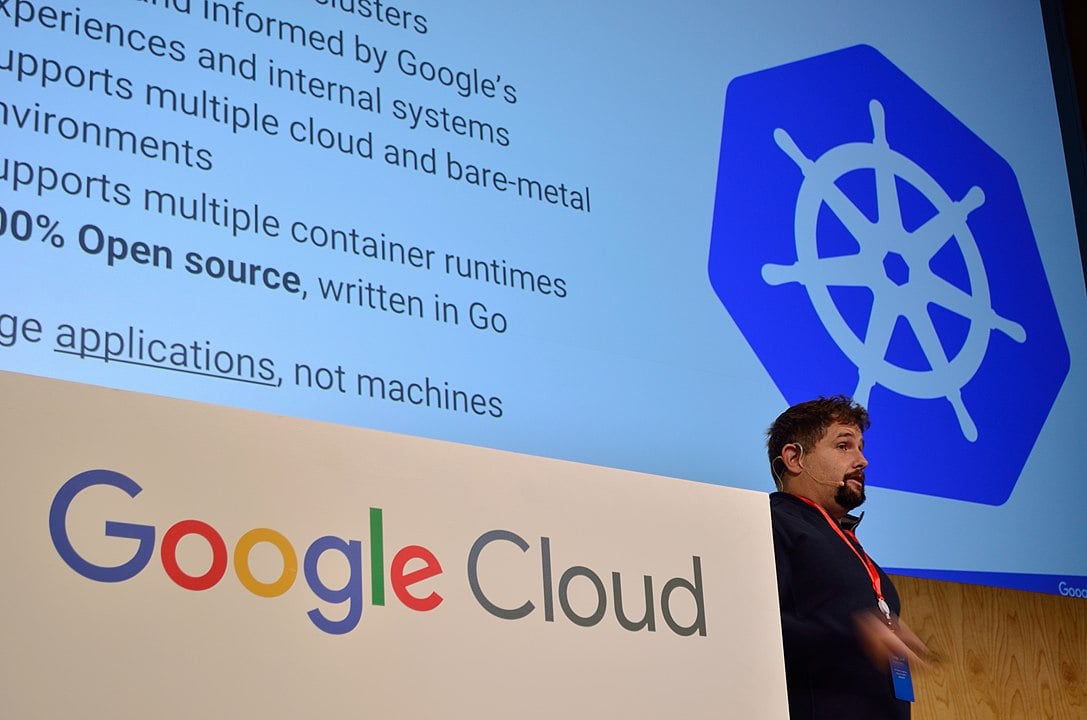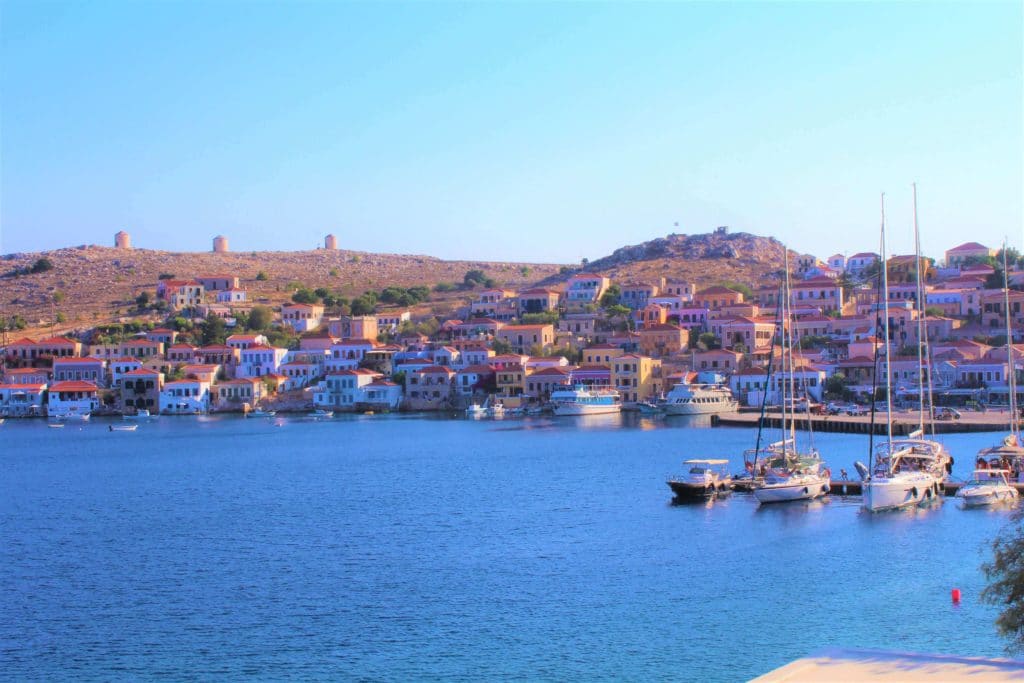
Far from the frantic daily life of today’s cities, the Greek island of Halki is a haven of peace and natural remedy for anxiety. Rarely, will you see a car circulating other than the local bus. Its emerald waters, its incomparable picturesqueness, the idyllic beaches, the combination of mountain and sea, and its history and culture are unique features.
It was afternoon when we entered the port of Halki leaving just behind us the two small islands of Nisos and Krevvati. In the background, the settlement of Nimborios, built amphitheatrically on the foot of a hill, resembled a painting in pastel shades as the sun made its last attempts to dive in the port. At the top of the hill, the three windmills in a row seemed to pose ostentatiously like ornaments.
You can reach Halki by a local boat from Kamiros, the cove located at the western end of Rhodes. This trip is quite short since only 6 km of sea separate the two islands. Itineraries run several times a day. A big sailing boat dominated like a huge sea whale in the small bay with its sails lowered. I had never seen anything like that before. As we passed it, I managed to read its name: ‘Maltese Falcon.’ Its three huge vertical masts supported many horizontal antennas. This whole metal complex was gilded as it intersected with the rays of the afternoon sun.
Out of curiosity, I later googled and learned that it is considered one of the most iconic state-of-the-art and luxurious superyachts. It is 88m long and can cross the Atlantic in ten days. Its open sails have an area of 2400 square meters while its three autonomous and rotating masts are 58 meters high each. Its owner is Elena Ambrosiadou, Hedge-fund manager of IKOS Asset Management in Cyprus.

Approaching the port, the two-story, 19th-century mansions of the old spongers were clearly visible. The houses were lined up along the harbor and their ceramic-tiled roofs and wooden, elongated rectangular windows could be seen from the distance. With my photographic lens, I captured their unique color shades, such as ocher, olive, fuchsia, apricot as they revealed themselves before my eyes. The frame was completed by the colorful wooden boats on the waterfront and their wavy reflections in the water.
As I was walking along the pier, I saw the bell tower of the Church of Agios Nikolaos dominating the port.
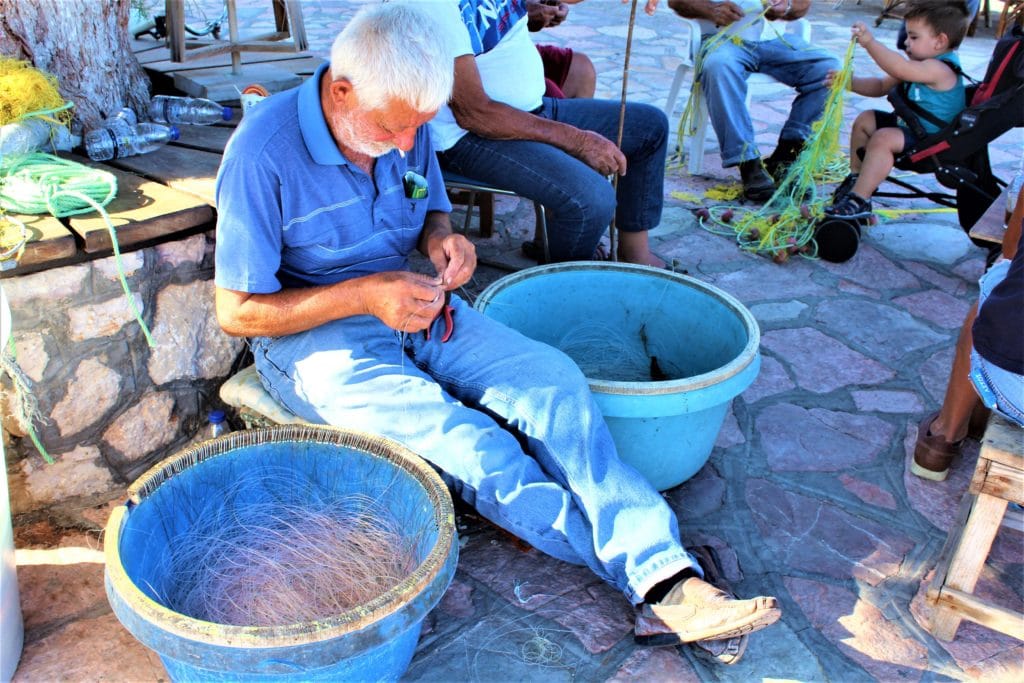
Some elderly, local island men sat on stools around a small flower bed untangling their nets while others sorted out the crop from small shrimps, a local delicacy.
We then followed the lady who welcomed us when we arrived and crossed the courtyard of the church of Agios Nikolaos, paved with a beautiful mosaic, before arriving at our small hotel.
Sponge divers of Halki
The view from our veranda was unique and unforgettable as was the first dive directly into the sea from a spacious patio terrace at the lower level of the building, where the moorage is located.
There, in the old days, spongers used to dock with boats and treadmills and unload their wares as they returned from the ‘hunt’ of the sponge. This terrace was called ‘snow’ because the sponges were ‘snowed’ there. It was a whitening process that upgraded the product and made it appealing to the tastes of the ladies of the time who used it for their daily care.
Sponges abounded on the shores of the Mediterranean and spongers reached as far as the coasts of Africa to collect this otherwise humble, animal species, as Aristotle first pointed out.
In the first years, the profession was very arduous and dangerous, a “mission impossible.” Gradually, the modernization and use of special devices led to overfishing of the sponges and the deforestation of the sea-beds with the result being that activity declined. At that point, many spongers migrated to Tarpon Springs, Florida, where they established a lucrative sponge industry; they are still active today. The Halkites in Tarpon Springs, referred to as “the Greek island of the United States,” never forgot Halki. Through their donations, many buildings were renovated and infrastructure was created. Other local immigrants in Weirton, West Virginia, USA donated the big clock to the island.
Like on a boat, moored ashore
Enjoying a slice of watermelon, a peach, and a cool juice on the upper terrace of the house, after the refreshing dip is like landing in paradise. From the outside, the sounds of laughter and music enjoyed my ears. The passengers of a sailing boat kept the pace of the day unabated, and the dives continued until dusk.
At the same time, on the other side of the port, the liner ‘Sebeco II’ was entering, performing perhaps the last route of the day from Kamiros of Rhodes to Nimborios.
In front of us, a little further out near the mouth of the bay, the small islet ‘Nisos’ was gushing another warm yellow light that seemed to come out of its bodies. Gradually, it began to lose this mysterious glow, and the light seemed to go out as if it was sucking it in itself leaving behind only a dark silhouette. The bright mist immediately jumped to the back islet as the sun tilted to the west while, at the same time, the moon appeared. it was probably still days away from filling.
Gradually, the lights began to come on through the rectangular windows of the colored parallelepiped houses from one end of the harbor to the other.
The first night walk in the port exuded a sense of calm which had nothing to do with the busy and noisy Greek islands. The small boats pulled, almost motionless next to each other, waiting for the next day’s movements on the nearby beaches of the island: Ftenagia, Kania, Areta in the eastern and northern part: Pontamos, Trachea, Yiali in the south. Impatient visitors, potential explorers of the island, approached to read the posted itineraries to plan their excursions. Walking along the harbor, it was impossible to resist the smell of octopus, squid, and fresh fish served along with local delicacies at local taverns.
Then, the multi-varied constellation of ice cream made from fresh local milk—with forty flavors of handmade ice-cream in a nearby patisserie—couldn’t go unnoticed.
The culmination of the challenges of our first day was the last evening of relaxation on our terrace. There, you felt like you were on a houseboat that, on the one hand, gave you the confidence that you were leaning on the ground but, on the other hand, launched you to fantastic destinations beyond the horizon line and over the canopy of the sky through the rhythms of the universe. This feeling followed you even when you fell into bed to sleep, and then, it was like living a dream within a dream.
The following day, walking a short distance and taking an exploratory walk through the settlement, we reached the sandy beach of Podamos while the next row was the beach of Areta by boat on the north side of the island.
On the Halki beach of Areta
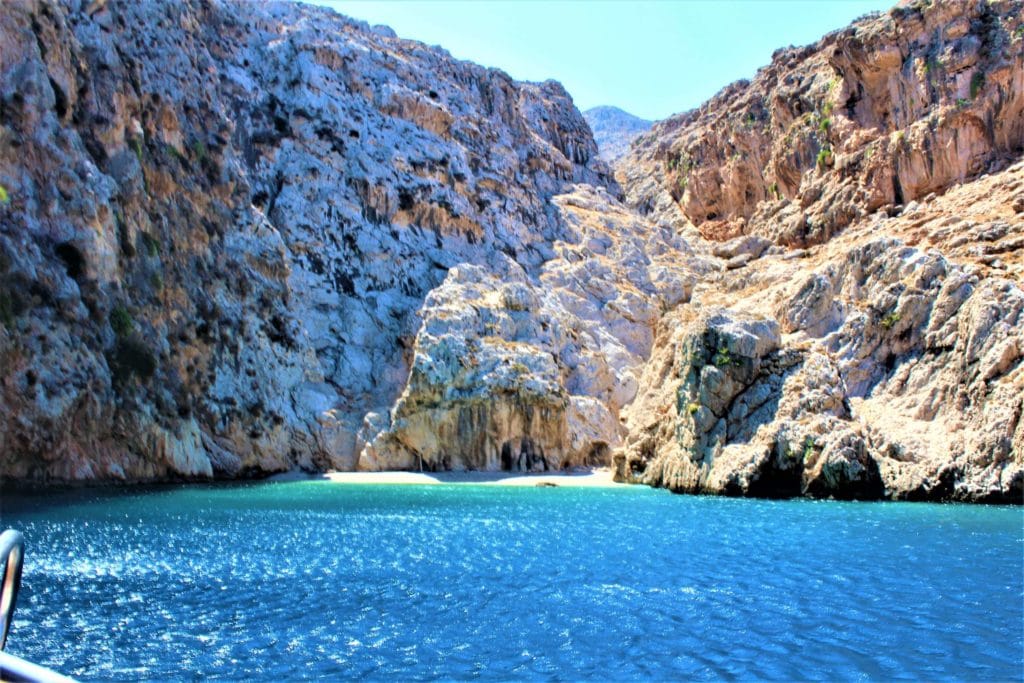
This small blue beach “sprouts” between towering, sharp and steep cliffs that refer to similar descriptions from the Greek mythology such as clumps of stones but without the element of wildness and crushing. Approaching and seeing the dreamy landscape, you feel that you have discovered an earthly paradise.
We got very close to the shore by diving from the boat ‘Giannis express’ with the captain, Mr. Michalis. He himself helped us to take our luggage ashore without getting the cameras wet while speeding up the disembarkation process to catch up on his next routes.
The few who got there started talking and exchanging information and impressions about the island. A young girl turned our attention to some shaggy kids, hanging puppet-like, who did incredible acrobatics balancing high on the cliffs that surrounded our creek. Someone else dived very deep and pulled out a “hippie” sea urchin with somehow unusually long, irregular, and sharp needles. We had seen its relatives in the port earlier, where, even there, the waters were crystal clear and the seabed was visible in every detail.
A gay couple from France, Antoine and David, told us that they considered the destination unique. They come to Halki every year and are very sad when time comes to return to Paris.
Swimming back and forth in the small bay of Areta, the feeling is unique. You have appropriated a corner of paradise for a while.
Equally revealing is to lie in the shallow waters, leaving your body free, where the gentle wave erupts, enjoying a relaxing massage on the small velvety pebbles of the beach.
Violin concert in a place and time we did not expect
Another pleasant surprise which enlivened our evening was awaiting us the same night under the steps of the large church of Agios Nikolaos in the port. As enchanted by the violin concerto of Yannis Kormpetis as everyone else was, we enjoyed a wonderful live performance of music with works by J.S. Bach, M.Vekiaris, and Ernst-Lothar von Knorr in a place and time we did not expect.
“Life goes on in difficult times, even on one of the remote small Aegean islands,” was a quick thought that flooded us with optimism.
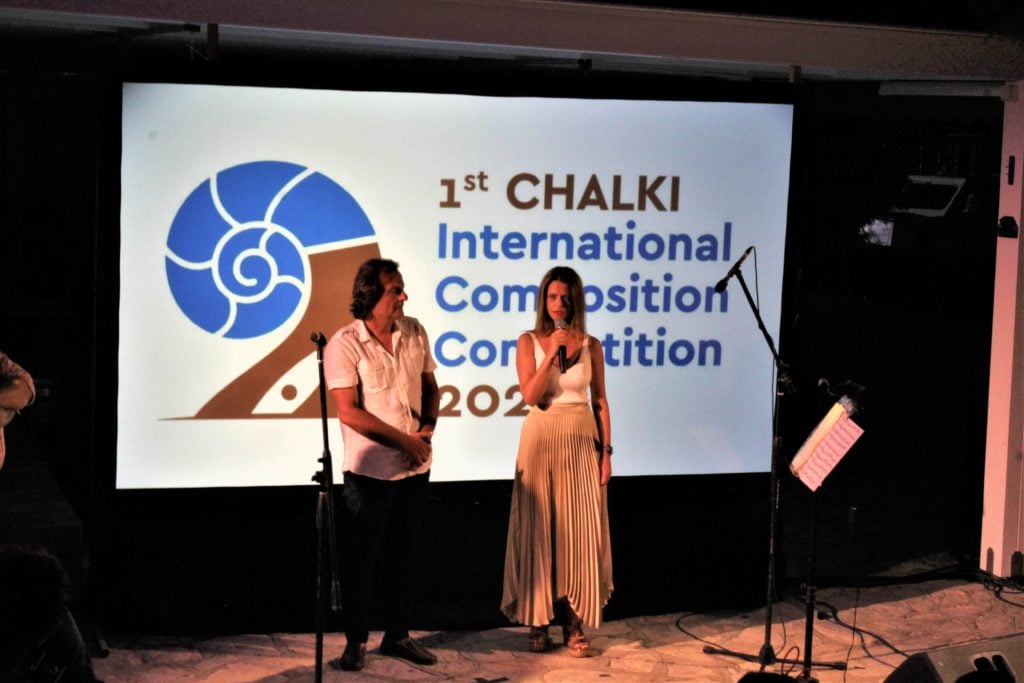
In the same context, the ‘1st International Chalki International Composition Competition 2020’, the next day, August 27, the initiative and organization of the award-winning composer Lina Tonia and Michalis Vekiaris in collaboration with the municipal authority, was another refreshing note.
Composers from all over the world submitted works for solo violin or violin and electronic sounds. From the 113 projects submitted, the committee selected eight that were presented and executed by Yannis Kormpetis while the final judgment highlighted the three best that were awarded. Talking to the organizers and the mayor of the island, we were informed that this competition has come to stay!
Tracheia Beach
On another day, Mr. Michalis took us by boat to Tracheia beach in the southern part of the island. We woke up early in the morning to catch up.
Walking in the port, we met a group that carried, like a trophy, a strange long and narrow fish they’d just caught before handing it over to the staff of a tavern for cooking. It is one of those little episodes of the daily series that unfolds on a small island in which, if you are lucky, you can witness or even participate.
The appointment for the trip to Trachea was agreed from the previous one. This time, however, we gathered only three passengers, and although the captain did not look very happy, the route was executed.
The small peninsula of Trachia separates two coves, the Flea with pebbles to the east and the Lakes with sand on the west. We approached Flea and got off.
We felt like shipwrecks when he left us there and Captain Michalis left quickly with the one-member crew. We explored both coves and ended up in Flea. The hours were spent swimming happily despite the high temperatures of August. In between, we took earthly breaths of coolness under the protective shadows of the rocks that formed small surface caves.
Fortunately, we were supplied with water because the boatmen’s programs had proved to be a bit ‘flexible’ to relaxed, and it did not take long to wonder whether the captain would remember to return to pick you up.
We were relieved to think that a sailboat was parked somewhere in the open and some tenants had dived for spearfishing.
Fortunately, we did not have to call for emergency help. Mr. Michalis came with a small deviation to the pre-arranged appointment. This time, however, he was even more nervous because he had difficulty navigating the rocky side of the bay. We had to do a quick jump to get on the boat while it was rocking back and forth.
The last passenger hesitated to jump, and then, Mr. Michalis started shouting nervously saying that because of her, his boat would fall on the rocks. He threatened to leave her there. Of course, there was no way we could leave without taking the girl with us. As it turned out, due to his haste, he did not show the required patience when approaching. Then, he came to his senses and with calm movements we picked up the young girl and sailed quickly to Nimborios. As we left Trachea, looking very high over the cliffs on the south side of Halki, we saw the castle of the Knights of Agios Ioannis which is supposed to be built on the site of an ancient Hellenistic Acropolis.
The same afternoon, we planned to visit the Castle from the side of the ‘Village,’ the old settlement of Halki in the interior of the island.
Rescue of immigrants in the Aegean
Returning to the port, the navy torpedo boat, which was stranded there in the morning, had long left.
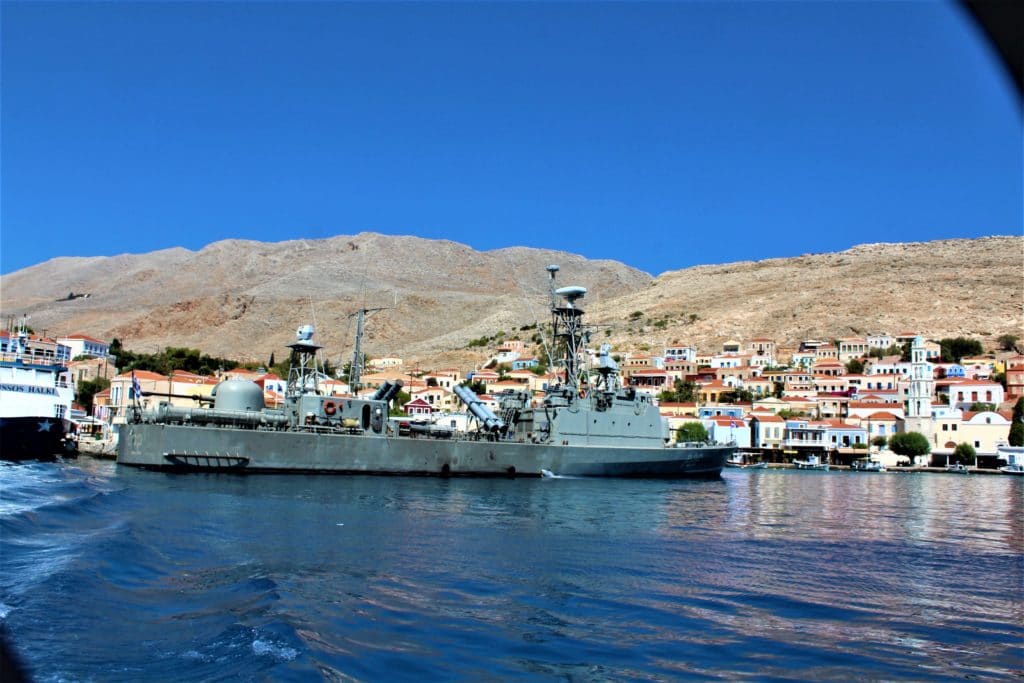
They had just made a two-hour stop to rest the crew, which had been on alert for months due to Turkish violations in the Aegean. In a conversation we had with them in the morning before we started for Trachea, they told us that every time they go out for a while on an island, the inhabitants of the Dodecanese welcome them and thank them for being vigilant so that they do not experience fear in their daily lives.
We also asked them if they were the ones who were called to rescue (smuggled) migrants off the coast of Halki three days earlier. We were told this was not the case; however, it is a common occurrence, and the ships that are closer are always running.
It is a fact that the night the ship sank, the incident upset the small community of Halki, and the local authorities made a quick plan to deal with the temporary accommodation of the 96 people who were rescued. We heard that they decided to open the school of the settlement. We learned from the electronic press that this was the largest rescue operation for migrants in the Aegean in recent months, and that in addition to the Greek Coast Guard, ten other ships, two helicopters, and a frigate participated.
Eventually, the alarm in Halki ended after most of the rescued migrants were transferred to the island of Rhodes. In recent years, Greece has become a gateway for thousands of Syrian refugees seeking asylum, as well as hundreds of migrants who, aided by Turkish smugglers, try to cross into Greece from neighboring Turkey. All this is happening despite the EU’s agreement with Turkey to reduce flows and combat human trafficking in the Aegean.
‘Chorio’ and the castle of the Knights
In the end, everything was fine since, despite the make-up of Captain Michalis, we managed and returned in time to catch the only bus that was headed towards the interior of the island to the abandoned village-ghost.
A distance of 2.5 km separates the port from the village, Chorio, which was the old capital of the island.
In fact, especially on that day, the bus would continue to the Monastery of Agios Ioannis of Aliargas for the evening service of the big celebration of the island. He left us at a point from where we took the uphill well-preserved winding alley, passing between the ruined houses of the village to the castle of the Knights that rises above the village like a crown on its ‘head.’
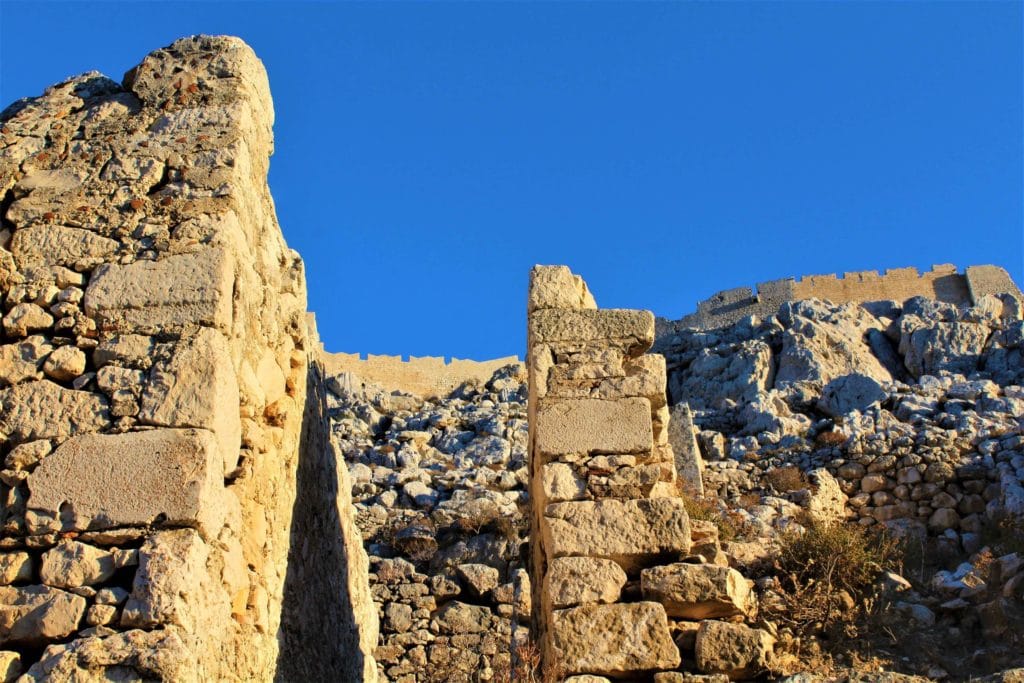
This was the old capital of the island that once numbered 700 houses almost glued together.
The inhabitants, in good times, may have reached four thousand. In their attempt to repel pirates and other invaders, they often resorted to the Castle, built by the Knights of St. John at the top of the hill, to protect themselves. However, there were also cases when they had experienced large and dangerous raids and then even the castle failed to protect them.
Built in the 14th to 15th century, the castle dominates the top of the hill. From the Hellenistic period, one can see the thrones of the Greek gods Zeus and Hecate inscribed in stone near the walls of the medieval castle.
Approaching the entrance, you see the coat of arms of the knightly order. The coat of arms of Grand Master D ‘Aubusson (1476-1503) among others is imprinted on the inner walls of the castle.
The view from the top is breathtaking. On one side the Carpathian Sea and on the other the Trachea Peninsula. The inhabitants of the castle could, from this height, control the movement at sea and locate would-be invaders. When pirate attacks subsided, in the 19th century, the inhabitants gradually became discouraged and began to move more freely on the island, cultivating the lowlands and gradually building the current settlement of Nimborio.
Evening prayer at the monastery of Ai-Giannis of Alarga
The descent from the castle was easier and we moved quickly to catch the next bus route, which picked us up from the point it had left us earlier, continuing to the monastery of Ai-Giannis of Alarga even further west and at an altitude of 386 meters. Arriving there, the sun was setting. Faithful people were already gathered in the spacious courtyard of the monastery and the atmosphere was reminiscent of mystagogy. The priests wore formal vestments and fancy garments and incense smell filled the air around the offerings that formed a small hill in the middle of the courtyard.
Someone told us that three years ago, strangers entered the monastery and stole the icon of Saint John of Alarga and many gold vows. The year 2020 was the first time that due to the pandemic the liturgy on August 28th at the monastery was without food and drink. The monastery, which celebrates on August 29th, offers delicacies such as baked lamb with potatoes and appetizers on the Eve service.
Wearing our masks, we boarded the same bus that brought us and took the road back to the settlement where we enjoyed a nice dinner with fresh fish.
Another day trip was successful, sprinkled with incomparable moments of the magic of Halki.
The feast of Saint John of Alarga on August 29th is very important for the island. Residents and expatriates from Halki look forward to it. The established festival in the port is one of the most famous in the Dodecanese. This time, however, everything was different. The traditional orchestra was installed on the balcony of the City Hall away from the public that was forbidden from approaching. However, everyone could listen to the traditional songs and music while sitting in the taverns of the port that were full from end to end. A few of us took the initiative and approached the steps of City Hall to photograph the music company that sang and played music with its own separate traditional musical instruments.
The days on the island passed quickly, and we lived with enthusiasm in every moment. It was not long before we discovered other beaches, such as Kania and Ftenaya, with a special character to them.
We also learned that Halki has its ‘satellites,’ thirteen small uninhabited islands, with an area of about 10,000 acres. Although we did not manage to visit the uninhabited island of Alimia, located between Rhodes and Halki, we nevertheless met Mr. Charalambos, a unique figure of Halki. A sheep and goat shepherd himself, he looks after his family’s flock. He has three sons, one of whom is Dimitris, the bus driver who travels to the island. Mr. Charalambos told us about his life in Alimia in the summers where for many years they cultivated wheat, barley, fava beans, and lentils and had mills to ground them. In winter, they returned to Nimborio.
On this island, there are remains from shipyards of the Hellenistic period, a medieval castle, ruins of barracks from the Italian occupation during the Second World War, and the ruins of the last settlement of the one that Mr. Charalambos lived in and still remembers.
Alimia, uninhabited since the 1940s, hosted the reality show Island in 2016 and 2017. Island is the corresponding Belgian Survivor. In 2014, Prince Charles and the Duchess of Cornwall, Camilla, arrived in Alimia on their friend’s yacht for a short vacation. Even Berlusconi was once interested in buying or renting it.
Halki is unique, unforgettable!
Far from the frantic daily life of today’s cities, Halki is a haven of peace and a natural remedy for anxiety.
Other than the local bus, rarely will you see a car circulating. Its emerald waters, incomparable picturesqueness, idyllic beaches, combination of mountain and sea, and history and culture are quite unique features. The most important thing is that it radiates a unique aura that makes you escape from stress and scourges. It is the perfect place to unwind. From the very first moment, it is easy to fall in love with Halki to the point that you won’t even want to leave and will start obsessively thinking about your return trip, especially now that the island is officially COVID-free.
We hope to meet with the people, mermaids, and fairies of the Halki island once again at the very first opportunity.
Fotini Maltezou is a freelance journalist and a contributor to major Greek publications. She is also a Physicist (B.Sc.) and Geophysicist (Ph.D.). She visited Halki in the summer of 2020.



